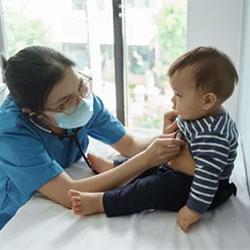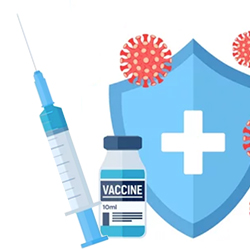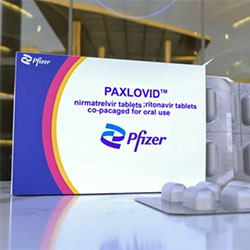By Marie Rosenthal, MS
Although many parents and pediatricians hailed the arrival of a pediatric COVID-19 vaccine for very young children, the practicalities of getting shots in arms concern them. Pediatricians Buddy Creech, MD, MPH, and Jason G. Newland, MD, MEd, both fellows of the Pediatric Infectious Diseases Society, provided practical information about achieving this goal.

“I think this is an important topic for us to discuss because we now have a vaccine against this pandemic virus that children down to 6 months of age can receive, and we’ve heard from parents and pediatricians for over a year asking when will this day come,” said Dr. Creech, the Edie Carell Johnson Chair and a professor of pediatrics in the Division of Pediatric Infectious Diseases at Vanderbilt University School of Medicine, in Nashville, Tenn.
However, others might be asking why this vaccination is indicated for young children, according to Dr. Newland, a professor of pediatrics at Washington University in St. Louis, as well as the medical director of the antimicrobial stewardship program at St. Louis Children’s Hospital. First, it is essential to explain to parents and caregivers the need for young children to be protected against COVID-19.
“We are still in a pandemic,” Dr. Newland said. At the beginning of the pandemic, children were seemingly spared from more serious disease, but “data have continued to demonstrate that COVID-19 has been a greater impact on our children’s lives [than we thought].”
As of June 29, more than 13.5 million children have tested positive for COVID-19. Hospital admissions and deaths have occurred, especially during the omicron waves. As of June 2, 442 children younger than 5 and 815 between 5 and 18 years of age have died from COVID-19. As of May 31, there have been 8,525 cases of multisystem inflammatory disease in children, resulting in 69 deaths, according to the CDC.
These COVID-19 pediatric deaths are much higher than those seen during a non-pandemic influenza season. “We always continue to recommend flu vaccine,” Dr. Newland reminded.
Many parents have concerns about vaccine safety, and Dr. Creech explained that was one of the reasons the vaccine took so long to become available to young children. “We wanted to make sure that we could find the smallest dose necessary to make the best immune response possible,” he said, and that takes time.
As a result of these “dose escalation, age de-escalation” trials, the dose changed. For the Pfizer-BioNTech messenger RNA (mRNA) vaccine, the dose is one-tenth of the adult dose; for the Moderna mRNA vaccine, the dose is one-fourth of the adult dose.
“What we know is that the reduced dose results in an immune response that matches what we see in adults,” said Dr. Creech, who is also the director of the Vanderbilt Vaccine Research Program, among other vaccine research roles.
And most of the adverse events are similar to those seen with other vaccines: low-grade fever, fussiness, injection site reactions and fatigue. Of note, the rare myocarditis/pericarditis or thrombotic events seen in some older children and young adults were not found in this very young age group, Dr. Creech said.
Right now, the dosing schedule is different between the two vaccines: the Pfizer-BioNTech series is three doses for children between 6 months and 4 years; Moderna is two doses given to children between 6 months and 5 years. This doing schedule is likely to change, Dr. Creech predicted, adding that he expects “some tweaking” of the regimens to add a booster to the Moderna vaccine.
Mixing and matching the adult vaccines is not only permitted, but there are data that the immune response might even be better if someone receives doses of both vaccines. However, that is not yet recommended for children. “I think it is going to be important for pediatricians and for families to understand that the dosing is different, and there will be opportunities for confusion,” Dr. Creech said.
Right now, it would be ideal for children to stick with one regimen, agreed Dr. Newland, but real-world experience might interfere with that practice. “It’s going to be easiest if they pick one and stick with that one,” he said, “but frankly, we all know that’s not going to happen. All of our hospital systems and healthcare systems are preparing exactly for that situation: the child that gets one Pfizer and then shows up, and all you have is Moderna.”
Another potential issue is a child who is on the cusp of the next age range; for example, a 4-year-old turning 5 or an 11-year-old turning 12. Drs. Creech and Newland both said not to delay starting the series.
“We are all about getting vaccinated now,” Dr. Newland said. “I wouldn’t wait. If you get the Pfizer 4-year dose, then you will get the 5-year-old dose the next time.”
Dr. Creech agreed. “The best vaccine is to get the one that is about to go into your shoulder, whether you are 4, almost 5, 5 or almost 6. I don’t think now in the middle of a pandemic is the time to wait. When that child reaches the next age group, they will receive a booster dose that has the next appropriate amount of vaccine.”
The age cutoffs are “somewhat arbitrary,” Dr. Creech admitted because it is not weight-based dosing. Some 4-year-olds are in the 95th percentile for weight and height, and physiologically might be more like a 5- or 6-year-old, while others would be much smaller.
Pharmacists' Role
One issue may be where the vaccine will be given for children. Although pediatricians prefer that children receive all their services within their medical home—the pediatrician’s office—there is no reason they could not receive the vaccine in a pharmacy as many adults do. However, state pharmacy boards might restrict pediatric vaccination by pharmacists.
Even the Public Readiness and Preparedness (PREP) Act sets some limitations, according to Michael Ganio, PharmD, MS, BCPS, FASHP, the senior director, Pharmacy Practice and Quality, at ASHP.
“Pharmacists can only immunize patients age 3 years and up under the PREP Act COVID declaration,” Dr. Ganio told Infectious Disease Special Edition. “I’m not aware of any states or territories that allow immunization under 3, but states and territories are able to establish their own rules on eligible age groups for pharmacists.”
Dr. Creech said some pharmacies might not have enough experience vaccinating very young children. “One of the reasons they don’t have a lot of experience is that we have typically consolidated vaccination of young children into their medical home, because there’s so much other preventive guidance that we want to provide.”
Dr. Newland added: “Even as we were developing vaccine clinics, even for 5 and up, that there are people who just aren’t comfortable vaccinating young children because they don’t do a lot of them. [The children] won’t sit still. There are ways of holding [them to vaccinate].”
But it is an issue, he added. “Access has been one of those issues we’ve struggled with during the pandemic,” he told Infectious Disease Special Edition. “It has been difficult to get a whole family vaccinated at the same time, which is something that we’ve had to continue to work and perfect and get better,” Dr. Newland said.
Regardless of where the child receives the vaccine, the most important issue is that they are vaccinated, they said.
“I think it’s important to realize that we don’t yet know how to predict which children are going to have bad outcomes from COVID 19,” Dr. Creech said. “We recognize that the burden of COVID-19 on children, compared to elderly adults or those with an underlying medical condition, has been less, but that burden is still higher than for many of the other respiratory viruses that we would typically see.
“I think parents are starting to realize that this is not the pandemic of 2020—it has changed. And as the waves have changed and new variants have come along, that requires us to make new decisions. So, the same decision-making process we made pre-delta has to change post-delta, post-omicron and now in light of new subvariants,” Dr. Creech said.




